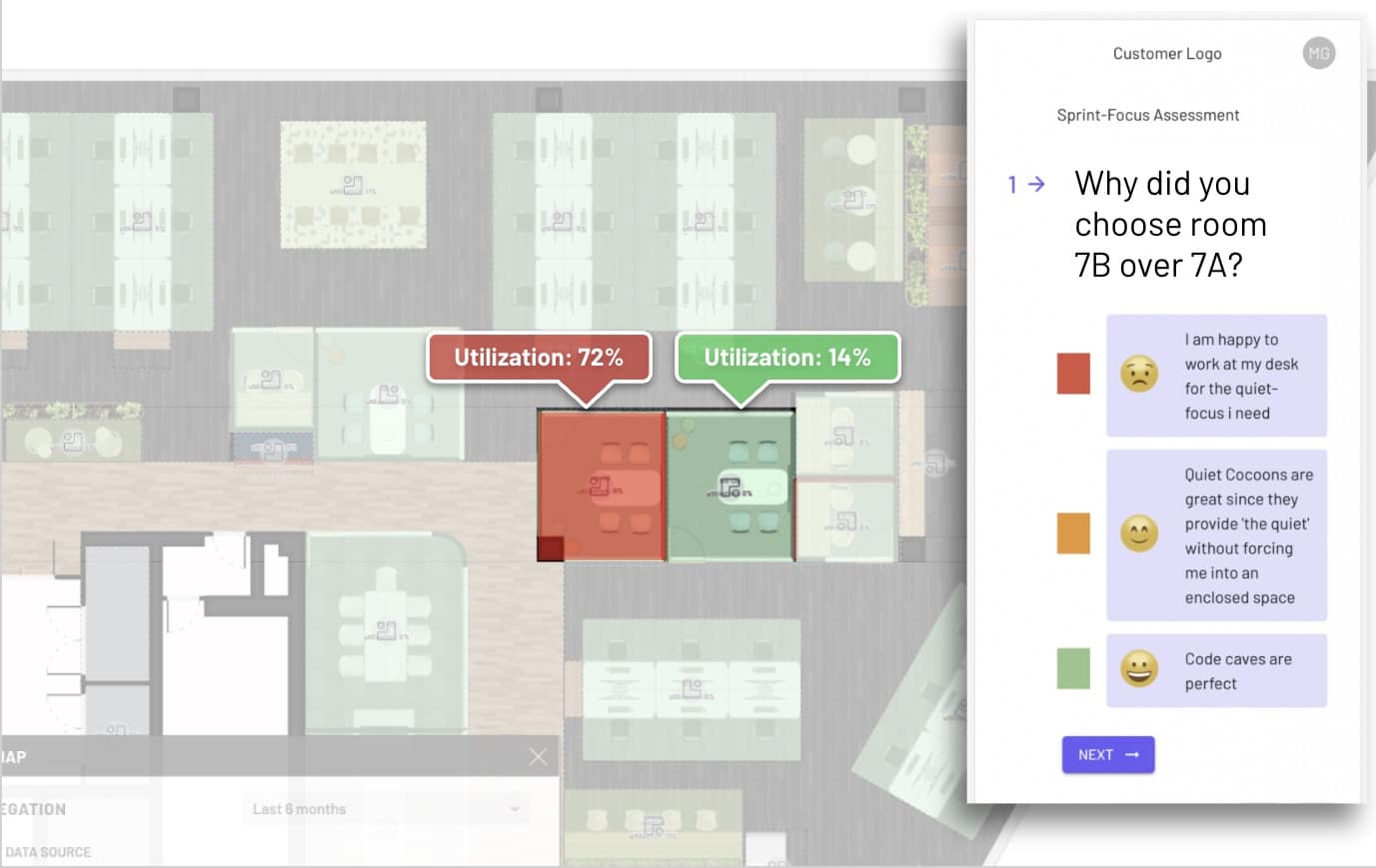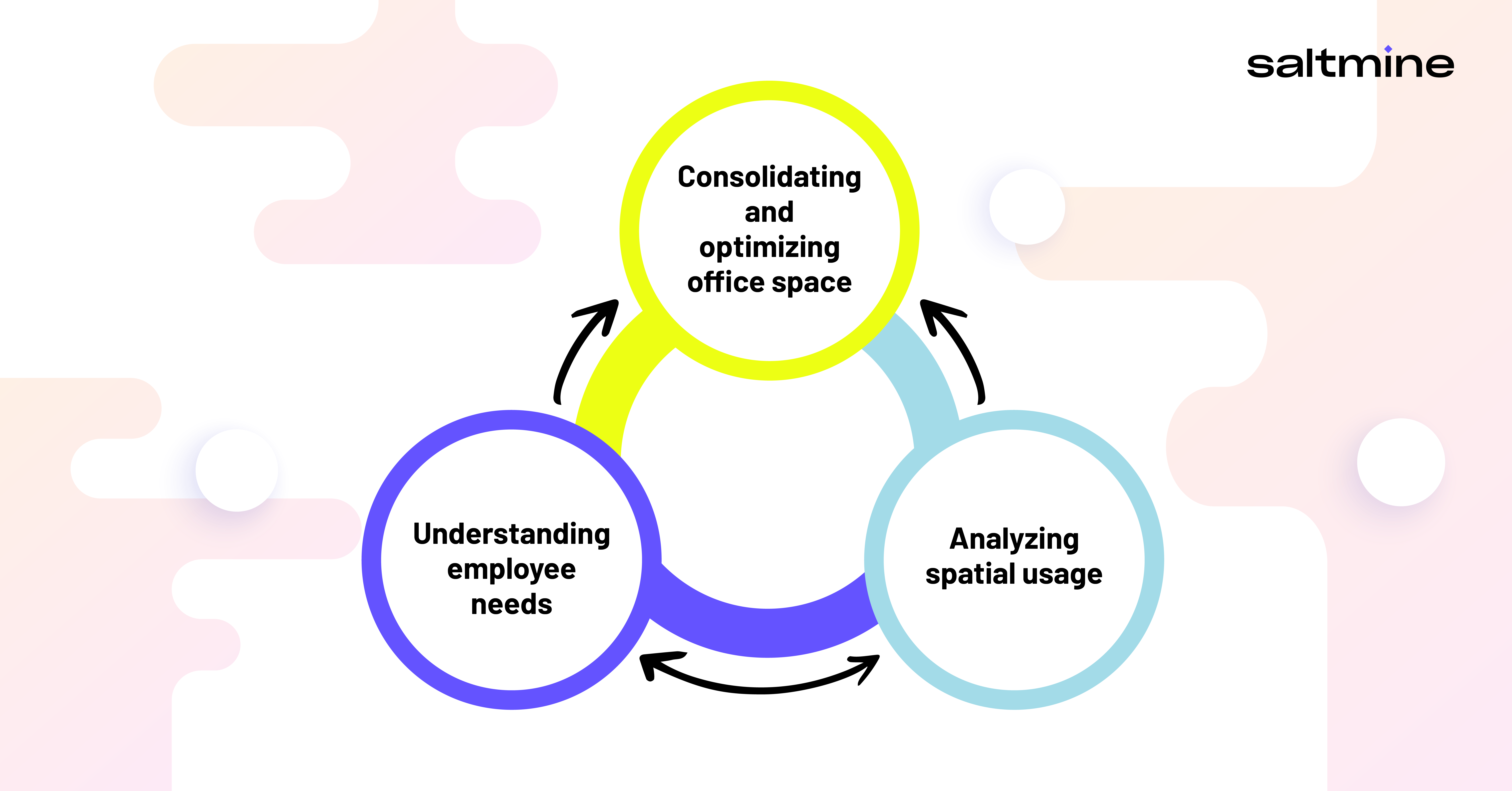Consolidating office space is a key initiative for many businesses as hybrid work continues to be a reality. In this blog post, we explore how understanding employee needs and analyzing spatial usage are the two essential steps in consolidating office space.
Are you looking to consolidate your real estate portfolio?
The modern workforce is constantly evolving and advances in technology and changes in the way people work, presents new challenges and opportunities for companies. One of the biggest challenges facing businesses today is how to optimize the use of office space.
As hybrid work continues to be a reality for most businesses, many companies are looking to reduce capital expenses and operating costs by consolidating their real estate portfolios.
In the US, office buildings hit 50% occupancy for the first time since the onset of the pandemic. And while many US cities are experiencing steady usage, this still means that large chunks of many office spaces remain vacant.
If done intelligently, more consolidated real estate portfolios better support flexible workplace strategies and result in higher employee productivity and happiness.
With that being said, achieving this outcome hinges on understanding people’s needs and analyzing how space is currently being used.
Understanding people needs
One of the most important things to consider when consolidating office space is understanding the impact it will have on the end-user—i.e., the employee.
If companies want employees to spend a significant amount of time in the workplace again, it is essential that the environment is comfortable, conducive to productivity, supportive of overall well-being, and makes a commute worthwhile. This means considering things like lighting, temperature, ergonomics, and acoustics, as well as creating spaces for collaboration, concentration, and relaxation.
To garner an understanding of people’s needs, consider sending out an employee survey with contextual visualizations and ask people how they feel about specific spaces.

spatial sentiments from employees.
Ask questions like:
- When in this particular space, are you able to concentrate?
- How much does lighting and acoustics affect your ability to get your work done here?
- Is this space comfortable to be in?
And so forth…
Understanding people’s needs is the keystone holding together an optimized office space. Without this understanding, companies risk not only paying for unused and underutilized offices, but an unengaged workforce and lackluster in-person culture.
Analyzing spatial usage
To consolidate office space effectively, companies need to evaluate their current layout and usage. Pre-pandemic assumptions cannot be leveraged for spatial decisions–making the analysis of current utilization crucial in revealing how spaces should be evolved.
This can involve taking a look at how much space is being used, how it is being used, and what can be done to optimize the usage.
There are various data points that can be leveraged to understand office usage, including:
- Occupancy rates: This data point measures how many people are in the office at any given time. It can be collected through occupancy sensors, badge swipes, or manual headcounts.
- Meeting room usage: Collecting data on how frequently meeting rooms are booked and utilized can provide insight into how often employees are collaborating and working together in-person.
- Desk utilization: Tracking which desks are occupied and for how long can help identify patterns in employee work schedules and how often desks are utilized.
- Foot traffic: Understanding how people move through the office space can help identify areas that are heavily trafficked or underutilized.
- Technology usage: Monitoring usage of workplace technology such as printers, copiers, and conference room equipment can provide insight into how frequently employees are using these resources and when.
- Temperature and lighting: Collecting data on temperature and lighting levels in different areas of the office can help identify areas that may need adjustment to improve employee comfort and productivity.
- Access data: Tracking when employees enter and exit the office can provide insight into work schedules and patterns.
Collecting and analyzing these data points can help organizations optimize their office space, understand employee work patterns, and make data-driven decisions about how to improve the workplace experience.
Furthermore, seeing all of this data on an actual floorplan helps workplace teams contextualize office usage. Using heat maps reveal opportunities where dead space can be re-designed and/or consolidated.

Optimizing and consolidating office space for a more engaging workplace
Once a company has a clear understanding of employee needs and analyzes space, it can start to look at ways to optimize and consolidate it.
One approach is to create flexible working environments that can be modified on-the-fly. From easily movable furniture and divider walls, to rolling white boards, configurable and multi-purpose spaces allow employees to change and morph spaces as their needs fluctuate.
Another approach is to use technology to optimize the use of office space. This can involve using occupancy sensors to track when and how space is being used, and then using this information to make informed decisions about how to optimize the layout.
Furthermore, using technology to optimize space should also help make sense of collected data. It’s one thing to capture data but another to be able to visualize employee habits—this provides meaningful spatial suggestions on how spaces could be more tailored to people.
One key aspect of consolidating office space is to create areas for employees to collaborate and socialize. This can involve creating spaces for informal meetings, coffee breaks, and other social events. It is important to remember that these spaces need to align with employee needs and evolving workstyles, as status quo and outdated standards may put company culture and employee attendance at risk.
The biggest benefit of consolidating office space is boosting employee productivity and happiness. By creating flexible working environments, providing a range of workstations, and promoting collaboration and socialization, companies can create a more supportive and engaging workplace that fosters a sense of community and a positive work-life balance.
In summary, consolidating office space is a complex and challenging task that requires careful planning and execution. However, when done correctly, it can have a significant impact on employee productivity and happiness, and have positive impacts a company’s culture.
***
Enjoying our blog? Be sure to subscribe to stay up-to-date on Saltmine's original content with the form below!



